Why a Multi-State Road Trip Is Even More Enjoyable in an EV

Given our situation, spending two months exploring the western United States with a baby during the pandemic felt no more complicated in an electric vehicle. In fact, traveling in an EV enhanced the entire experience.
Our plan was ambitious: after living overseas for 13 years, we intended to reconnect with America in style. We’d embark on a 5,500-mile journey through the western U.S., visiting friends and family in California, Arizona, New Mexico, Colorado, Utah, Idaho, Oregon, and Washington. Our ride would be a brand new Ford Mustang Mach-E California Route 1, boasting an official range of 304 miles (though we discovered it could often stretch to 325–340 miles on certain flat stretches).
We departed from San Francisco on December 10, 2021, aiming for the Holiday Inn in Santa Clarita, a distance of 371 miles for our first day. The car’s navigation took care of our charging stops, and we set off with confidence—only to encounter a significant oversight.
At our initial bathroom break, a brief stop at a gas station, we remained optimistic. Three hours later, we reached our first charging station in Firebaugh, near Fresno, and after a bit of fumbling for five minutes, we started charging. Everything appeared to be on track.
It was at our next stop that we recognized things had gone awry. Our four-month-old woke up hungry, prompting us to detour at Buttonwillow, near Bakersfield, where there were no services or charging options. An hour later, we unexpectedly needed to charge at a rest area in Lebec, as the car hadn’t factored in the extra effort required to ascend to higher elevations. Our baby woke again, turning what should have been a quick 10-minute charge into a 45-minute baby care session.
That’s when the realization hit us. In that instant, we finally understood what needed to change.
Plan Your Own Charging Stops
When we allowed the car to determine our charging stops, its built-in navigation prioritized minimizing total travel time. Since the battery charges fastest when it’s nearly depleted, the algorithm prompted us to charge when the battery was around 20 percent, instead of filling it up to the standard 80 percent. This approach led to three main issues:
- We spent more time during breaks feeding ourselves, taking restroom breaks, and caring for the baby than it took to charge the car (about 25 minutes at a level 3 charger averaging 75 kW, which is only half of the total potential charging speed for our vehicle). Thus, shortening charge time wasn’t really necessary.
- We preferred to align our stops with our baby’s naps and feeding times rather than simply maximizing driving stretches, which made for a less relaxing journey.
- The car was optimizing our route for a lower battery to recharge faster, but weather changes and elevation shifts impacted battery performance, leading to additional charging stops. As we traveled out of the Central Valley and over the Transverse Range, temperatures dropped significantly. Although the planning system helped prevent issues by knowing where the chargers were, our last stop wasn’t how we would have liked to structure our time.
For the next two months, we adjusted our approach, selecting charging stops 1.5 to 2.5 hours apart to better fit our needs.

Photo by Weldon Kennedy
A Network of EV Charging Stations
Charging stations are plentiful throughout the western U.S. We traveled through some of the most sparsely populated regions, including the Sonoran Desert, Great Basin Desert, and winding two-lane highways across the Columbia Plateau. Despite this, chargers were always accessible, and we never approached using the full 300-mile range of our vehicle—until we reached Fort Collins, Colorado.
We arrived at an EVGo charging station located at the Fort Collins Museum of Discovery to park while enjoying a brisk brunch at the well-known Ginger and Baker, which generously offered outdoor seating despite the winter chill. However, we couldn’t get the charger to work, forcing us to use an Electrify America station on our return to Denver.
Almost unintentionally, we found ourselves relying solely on Electricity America and ChargePoint rapid chargers during our travels. Both networks are excellent. ChargePoint even provides uptime and availability information, allowing you to see how many charging plugs are open. Following our EVGo experience, we chose to stick with these trusted networks, which offer extensive coverage across the country, so we never needed to seek alternatives.
Locating Hotels with EV Chargers
Most days, we charged at the hotel and supplemented with one or two rapid chargers along the way. We discovered charging stations at a variety of hotels, and nearly every booking site allows you to filter for those with charging options. Salt Lake City, Utah, was the only place where we couldn’t find a suitable hotel with chargers. However, upon arriving at the TownePlace in Murray, just south of Salt Lake, we were pleased to find four newly installed chargers that hadn’t yet been listed on their website. The infrastructure is expanding rapidly.
We would typically drive 150 to 200 miles before taking a rapid charging break. During this time, we would use the restroom, feed the baby, and often grab a bite ourselves. Sometimes we’d even use the restroom again, just to be safe—hydration is key! We consistently finished charging well before we were done with our other activities. If you’re road-tripping with kids or just want a chance to stretch your legs, you’ll likely find charging time is not an issue at all if your car can charge at 75 kW.
Understanding How EV Charging Works
It's crucial to differentiate between home chargers and the rapid chargers you encounter on the road. At home, you can plug into a standard wall outlet, providing about 1 kilowatt of charging per hour. Alternatively, you can install a more powerful charger, known as a level 2 charger, which delivers around 4–6 kW. However, the true powerhouses of charging are found on the road, where level 3 chargers operate at 50–150 kW, with some of the latest models and vehicles achieving even faster rates.
Our vehicle is equipped with an 88 kilowatt-hour battery, offering an official range of 304 miles. Since our typical drive lasted about two hours, we generally used around 50 percent of our battery between charges. Most chargers allowed us to top up in 20 minutes or less. This also highlights that you don’t need an extensive range to embark on a trip like ours; nearly everything we accomplished could have been done in a car with a 260-mile range.

Photo by Raisa Nastukova/Unsplash
The Unexpected Perks of Road-Tripping in an EV
If you own an EV, take it out on the open road. If you’ve never experienced a long-distance drive in one, the difference is remarkable. Friends we met in Seattle dubbed it “magic on wheels.” Compared to our old 2005 gas-powered car, calling it magic might be an understatement. Without the thousands of tiny controlled explosions, it doesn’t vibrate the same way and operates with a serene quietness. The ride is smooth and driving feels effortless.
After a long day of driving in our EV, we still felt energized and ready to explore parks in Salt Lake City, enjoy beers in Flagstaff, or hunt for the best Vietnamese food in Denver.
Our go-to meals consisted of fresh veggies, hummus, and cheese from our mini-fridge. With such a large battery onboard, plugging in a small electric cooler only cost us a mile or two of range each day. In return, we kept pumped breastmilk chilled and enjoyed the best road trip snacks ever, without the mess of ice or the hassle of refreezing blue ice. Another win for the EV.
From Bandelier National Monument to a quiet street in Portland, people frequently asked us: How did we get the car? Admittedly, that was the toughest part of the journey, requiring the family to contact every dealership within a 50-mile radius. However, supply is improving, so we hope you’ll join us in embracing this new and enhanced way to experience the classic American road trip.
Weldon chronicled his journeys through a series of videos. Visit YouTube to catch more highlights from the trip.

1

2

3

4

5
Evaluation :
5/5